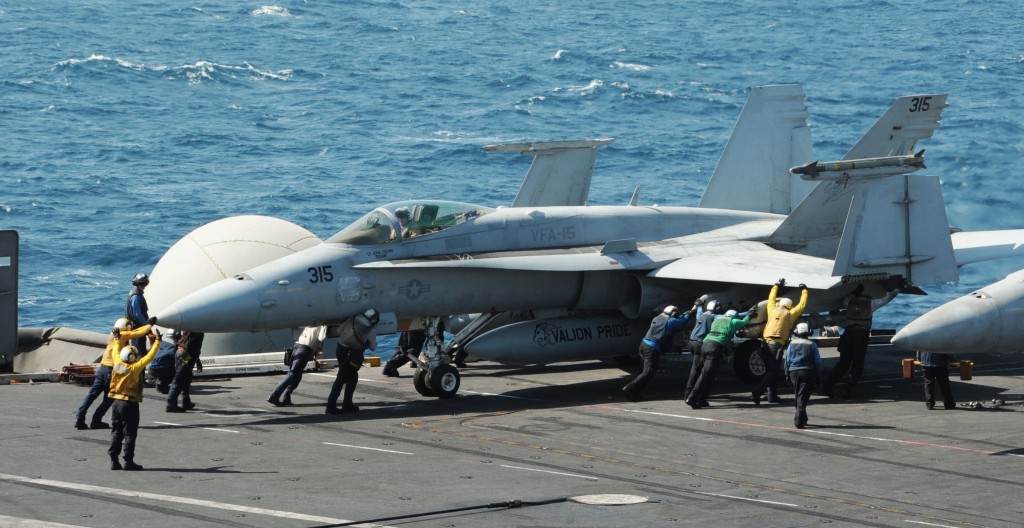62 % Of F-18 Hornets Unfit To Fly, Up To 74% In Marines
Posted on

F-18 Hornet aboard USS George H.W. Bush
UPDATED with Marine Corps data CAPITOL HILL: More than 60 percent of Navy and Marine Corps strike fighters are out of service, the Navy confirmed today. While 62 percent of fighters are effectively grounded, the overall figure for all naval aircraft is 53 percent. [UPDATE: With some of the oldest fighter jets in service, Marine Corps figures are even worse: In December, 74 percent of Marine F-18 Hornets were not ready for combat — 208 of 280 aircraft; see below for details.] Such striking numbers underline why Defense Secretary James Mattis, military leaders, and many legislators have prioritized fixing readiness for the force we already have, an immediate crisis, over the long-term build-up of a bigger force that President Trump promised in his campaign.
[Read in-depth analysis of the F-18’s readiness “death spiral”]
Pro-defense lawmakers still want the build-up, but they acknowledge it’s going to take years, if not decades. For example, legislators have asked the Congressional Budget Office to study alternative spending plans to build a 355-ship Navy over 15, 20, 25, or 30 years, the new House seapower subcommittee chairman said today.
“It’s important that we build ships but it’s also equally as important that we maintain the ships that we have,” said Rep. Rob Wittman, who’s taking over the Seapower & Projection Forces panel from fellow Virginian Randy Forbes. “Our commitment there will be equally as fervent as for building new ships.”
What’s striking is less what Wittman said — he used to chair the readiness subcommittee — but where he said it: to a group of shipbuilders. The Amphibious Warship Industrial Base Coalition (AWIBC) is largely the creation of Huntington-Ingalls Industries, which owns Ingalls Shipbuilding in Mississippi and Newport News in Virginia, and its 2017 agenda is all about accelerating construction of new ships. It can’t have been too cheering to hear one of their chief cheerleaders on Capitol Hill is considering a 30-year timeline to build the 355-ship fleet.
Marine Corps Commandant Gen. Robert Neller, speaking to the shipbuilders just after Wittman, was even more emphatic about readiness. “Secretary Mattis is — for those of us who’ve worked for him before — he’s always very clear, he’s always given good guidance,” Neller said. “Right now restoring readiness is the priority,” though the Pentagon team will try to fill “holes in programs” where possible.

General Robert Neller
Issues with insufficient flight hours for pilot training, insufficient spare parts to keep planes flying, and so on are at the top of the readiness priorities, Neller added. These problems tie directly into the low readiness figures for naval aviation, which were first reported by Defense News last night, acknowledged by Vice-Chief of Naval Operations Adm. William Moran at a hearing this morning, and clarified for Breaking Defense by a Navy spokesperson this afternoon. It’s likely Marine Corps Hornets are worse off than the reported figures indicate, since they’re some of the oldest fighters in the military.
[UPDATED:] Marine Corps figures provided Breaking Defense confirm this guess. Of 280 Marine Corps F-18s, 109 are in long-term maintenance — heading to or from depots, in depots, or simply “out of reporting.” The other 171 assigned to squadrons, but 58 percent of these 171 aircraft are in shorter-term maintenance, leaving 71 to 72 aircraft, on average, ready to fight. That’s 42 percent of the Hornets assigned to squadrons but only 26 percent of the total inventory.
[UPDATED:] It’s also worth noting that the services don’t report their readiness rates this way: They simply look at aircraft “in reporting” — in this case, the 171 assigned to squadrons — and figure how many of them are ready to go — in this case, 42 percent. The aircraft in long-term maintenance are “out of reporting” and not included in the calculation. But the figures from the Defense News story and confirmed by the Navy were calculated as percentages of the entire aircraft fleet, and we’re trying to give an apples-to-apples comparison.
“We’re hopeful that all the discussion and all the talk is going to provide the resources that we think we need,” Neller said, “(but) none of this is going to happen overnight… even if you had the funding to increase the acquisition of airplanes or even if you had the money to increase the throughput through fleet readiness centers.”
Subscribe to our newsletter
Promotions, new products and sales. Directly to your inbox.
